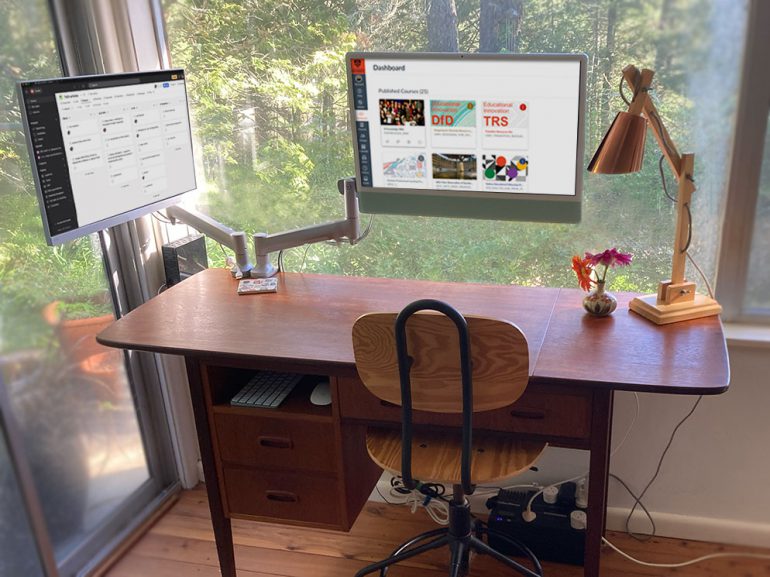The rapid development of generative AI and all its amazing possibilities is quite rightly drawing a lot of attention as people in all industries and fields explore its capabilities and implications for their contexts. In this novel landscape of significant change it’s easy to inadvertently minimise the ways in which the range of more familiar tech tools can be used to enhance teaching and learning. This everyday innovation selection features examples of teachers enacting helpful, student-focussed, and effective approaches using standard enterprise tech tools.
Janine Coupe, Louise Luff, Ben Lay and Kaiying Ji: Excel – joining the dots to develop professional judgement
Janine Coupe is a Senior Lecturer and a Fellow of the Higher Education Academy (FHEA). Louise Luff is a Lecturer and a fellow of the Higher Education Academy (FHEA). Dr Ben Lay and Dr Kaiying Ji are Lecturers. All lecture in the Discipline of Accounting, Governance & Regulation at the University of Sydney Business School.
The complex professional judgements required of accountants and other business professionals contain many sub-decision points, making critical thinking a central component of the higher education curriculum. To support students to develop these skills, we designed an interactive MS Excel professional judgment tool which included instant feedback, guided progression, and support for the exam including examples and evaluation guidance. Central to this interactive tool is conditional formatting, so students can explore ‘what if’ scenarios. Students often find accounting very abstract, so we included data and details to help bring the scenarios to life. The interactivity was achieved using a simple Excel ‘green to go’ function – when students select from a drop-down menu, the cell turns green for the correct answer or red for incorrect. Getting a red cell after choosing a response encourages students to look for a different basis for their professional judgment, helping them to ‘join the dots’ and develop their understanding of how changes in parameters and decision points affect decision-making. In class, tutors model the Excel file’s interactive decision-making processes to guide students in their critical thinking, reflection, and active discussion.
After introducing this tool we saw an improvement in the quality of the critical thinking essay responses in the final exam with an increase in the average mark of ~48% for this question, and had feedback from students that the Excel format had helped them in consolidating the knowledge learned in the lectures, and that they’d appreciated the more active discussion in class.
Read more about the tool in this article.
Jessica Kean: Canvas as a site of hospitality for first year students
Dr Jessica Kean is a lecturer in in FASS and the DVC-E. She teaches undergraduate Gender and Cultural Studies and Industry and Community Project Units and is an accredited university-wide peer reviewer of teaching. In 2019 she completed the Graduate Certificate of Higher Education and was awarded Fellowship in the Higher Education Academy. In 2022 she received a FASS Teaching Mentor award.
Canvas is usually a student’s first point of contact with a unit of study. As such, it is also a teacher’s first opportunity to demonstrate hospitality for their students – combining a warm and welcoming teacher presence with the kind of practical information that will give new students the best possible chance of arriving to class in week one feeling comfortable. As educators we often think first about how to communicate learning outcomes and assessment, but students transitioning into a totally new learning environment often have more immediate concerns. Taking cues from the UDL framework I have iteratively designed an orientation module for my first year undergraduate unit prioritising the foundational information all students need in their first encounter with university studies. The welcome module answers some practical questions that might help students walk into week one with confidence, questions that might be overlooked by those of us whose own first weeks may have been different or long past: What does our lecture hall/tutorial room/learning space look like and where should I sit? How can I find my rooms and what should I bring? Will the lecturer call on me, and is it ok to raise my hand? Who are my teachers and what are their jobs, exactly?
Explicitly answering questions like these is not only important for equity, it stands as a practical demonstration of care. When when matched by a friendly and welcoming tone, and combined with humanising teacher introductions and student ‘Introduce Yourself’ discussion boards, we also address a second set of concerns students may be carrying with them – Am I welcome here? Will my teachers help me? Is this a space where I can learn? – and give reassurance.
Rebecca Roubin: Switching to Ed Discussion for greater engagement
Dr Rebecca Roubin, a Lecturer at the Sydney Pharmacy School, The University of Sydney, is dedicated to innovative research and teaching that transforms pharmacy education to meet current and future practice needs. As the Assessment Coordinator and eLearning Coordinator for The University of Sydney’s Pharmacy Programs, she plays a pivotal role in shaping the learning experiences of aspiring pharmacists.
This innovation is a simple switch of a tech tool in a second year Master of Pharmacy unit, which greatly improved engagement and learning outcomes for the students.The course is run in a hybrid mode with some asynchronous activities and we saw an opportunity for online discussion to enliven the content. We set up Canvas discussion boards but saw little engagement, so asked our students for their thoughts. Specific feedback came through about a lack of comfort using the boards as the interface didn’t feel very welcoming (some said it had a very 1980s feel!) or give them an opportunity to find out more about the topics. I tabled alternative discussion tools at the Student Staff Liaison Committee, and one of the proposed ideas was to try Ed Discussion*.
‘Ed’ is fully integrated with Canvas, easy to use, and much more like the chat systems that students are used to with their social platforms. When we implemented it we saw a dramatic improvement in engagement, both participation and views, across the entire cohort throughout semester. Students fed back amongst other positive notes that they loved the format, and we’re now introducing Ed Discussion across many different pharmacy units because of the benefits. I’m very proud of the positive impact it has had on student engagement in my unit.
*EdSTEM and Ed Discussion are available in many Faculties and Schools. Check with your local education team to find out if you already have access, or to request the tool.
About everyday innovation
Everyday innovation is about small, clever, creative and caring things that teachers at Sydney are doing in their classes. The scale of focus of this series is the quotidian, the extraordinary ordinary, the things we can do at arm’s reach, are comfortably within our resources, and are experimental – the stuff we try out together with our students in the lively spaces of our classes. Small ideas, while often overlooked on the big stage of awards and such, are special because they’re sensitive to their specific contexts. They’re often the simplest to implement and can allow nimble adaptations on the fly. These ideas deserve recognition and celebration! Let us know about your, or a colleague’s, everyday innovation by emailing us at [email protected].
Read other articles in the everyday innovation series for inspiration in your own teaching.





